upright go pro
sep-nov 2024
class project (uxdg-740)
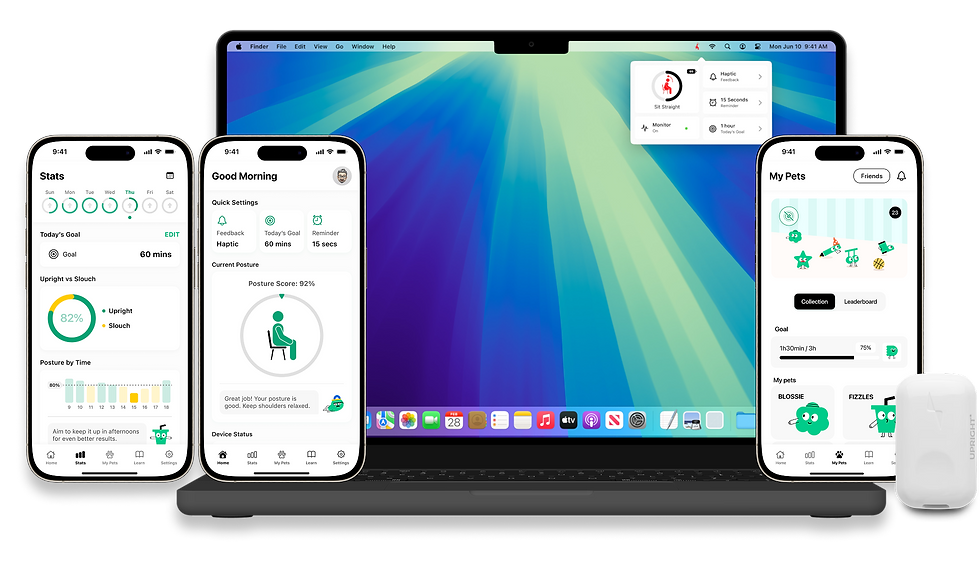
User Research, UI/UX design
10 weeks
Dawna Zhang | Sarath Nekuri | Chaehyeon Iris Kang | Randeep Satish
overview
Upright Go helps users improve posture but struggles with high dropout rates and low retention. This project aims to enhance engagement and usability through improved feedback, habit-forming strategies, and a more engaging user experience.
who is user?
Young, busy desk workers
my main responsibilities
📌 Need-Finding Through Primary & Secondary Research
💭 Ideation & Prototyping Based on Key Insights
👩🏻💻 Design, Test & Iterate
Problem statement
Despite its innovative approach to posture tracking, Upright Go faces challenges with high user dropout rates and low user retention. Many users discontinue use after a short period due to factors such as discomfort, lack of engagement, or difficulty integrating the device into their daily routines. Addressing these issues is crucial for enhancing user experience, increasing long-term adoption, and maximizing the product’s effectiveness.
HMW
How Might We raise awareness about the significance of maintaining proper sitting posture and Better understanding of their postural habits?
How Might We encourage users to maintain proper posture and incorporate regular movement into their routines?
How Might We encourage users to maintain proper posture and incorporate regular movement into their routines?
solution
Minimize Workflow Disruptions
Implement features like real-time feedback, tutorials on proper posture, and progress tracking to educate users and promote postural self-awareness.
Incorporate Motivation Through Gamification
Introduce virtual companions and social features, such as collecting virtual pets and competing with friends, to engage users and encourage consistent habit-building.
Increase Awareness of Proper Posture
Implement features like real-time feedback, tutorials on proper posture, and progress tracking to educate users and promote postural self-awareness.
GOAL 1: Increase Awareness of Proper Posture
How Might We raise awareness about the significance of maintaining proper sitting posture and Better understanding of their postural habits?
real-time feedback
Real-Time Tracking for Perfect Posture!
Comprehensive Posture Report
Track your progress with detailed insights!
Personalized Posture Tips
Get tailored tips based on your posture data.


Suggested Videos:
Get tutorials based on your posture data.
Master in Posture:
Learn from a library of expert-led videos.

GOAL 2: Minimize Disruption to Workflow
How Might We encourage users to maintain proper posture and incorporate regular movement into their routines?
Feedback Preferences & Reminder Customization
Personalize how you receive posture feedback with adjustable reminders—stay on track without disruptions!

Desktop Integration
Seamless reminders to stay upright without interruptions.

GOAL 3: Incorporate fun and Increase motivation
How Might We encourage users to maintain proper posture and incorporate regular movement into their routines?
Unlock virtual pets
stay motivated with pet reminders and companionship!



Social Interaction Feature
Stay motivated with daily leaderboards, share progress, and check out friends’ pets!


RESEARCH

We reviewed global data on ergonomics to understand the broader context of posture issues

We collected quantitative data to gauge the prevalence of posture problems and tool usage.

Finally, we conducted interviews to dive deeper into individual experiences with posture.
Can people maintain proper sitting posture?
no!
85%
don’t sit with proper posture.
( 75%)
Slouching or Hunching
(40%)
Forward Head Posture
(67%)
Unconsciously Raised Shoulders

Problem Statement
Desk workers are experiencing muscle pain and discomfort due to poor posture during prolonged sitting. Many are unaware of proper posture techniques, impacting productivity and long-term well-being.
What about people's awareness of their sitting posture?
USER QUOTE - -ENGINEER, 33
"My posture is probably really bad,
but why should I pay attention to it?
Maintaining good posture seems so difficult!”
USER QUOTE - -FINANCIAL ANALYST, 28
"To be honest, I don't know what the correct sitting posture should be.”
75%
Participants believed they were sitting or standing correctly
68%
but posture analysis showed that
Them were adopting positions that could lead to musculoskeletal problems.
INSIGHT
There is a gap between people's perceived knowledge of posture and their actual practice.
01
How Might We raise awareness about the significance of maintaining proper sitting posture and Better understanding of their postural habits?
What about people's perception of posture?
38%
office workers experience MSDs within a week, and often use pain as a reminder to change their posture to alleviate discomfort
USER QUOTE - -ENGINEER, 33
"Even though I know my posture might be an issue, asking me to focus on it while I'm concentrating on work feels like it goes against my main goal at that moment. ”
USER QUOTE - -FINANCIAL ANALYST, 28
I usually don’t notice my posture unless I start to feel some pain, which prompts me to stretch a little.
02
How Might We encourage users to maintain proper posture and incorporate regular movement into their routines?
USER QUOTE - --SENIOR IT CONSULTANT (TCS), 33
“I know I should improve my posture, but it feels boring and hard to stick with. ”
78%
of users: ” Improving posture is challenging, boring, and hard to maintain.”
INSIGHT
Users need a more engaging and appealing way to motivate them to change their habits.
03
How Might We encourage users to maintain proper posture and incorporate regular movement into their routines?
Got it, the issues are clear.
Now it's time to generate some ideas.
Competitor Analysis
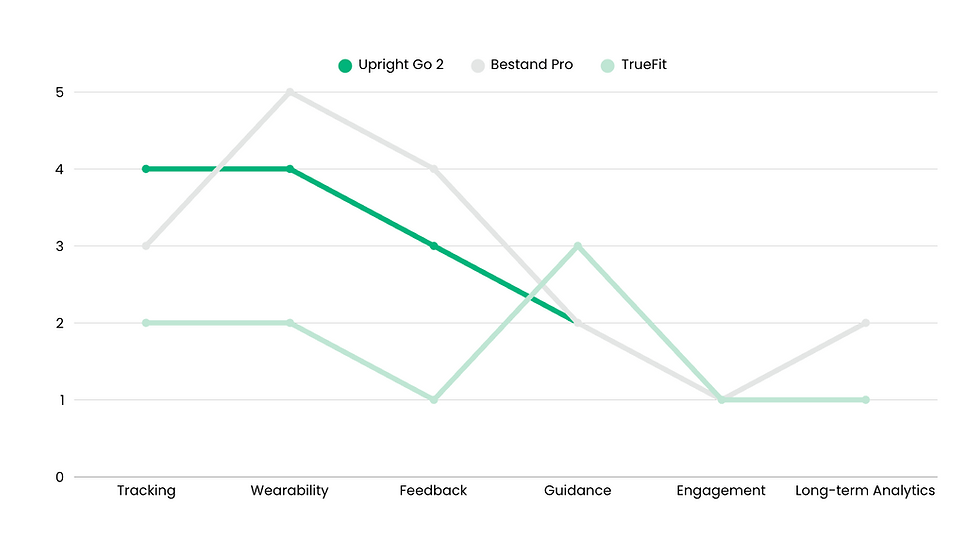
Identify the opportunity of enhancing the product.
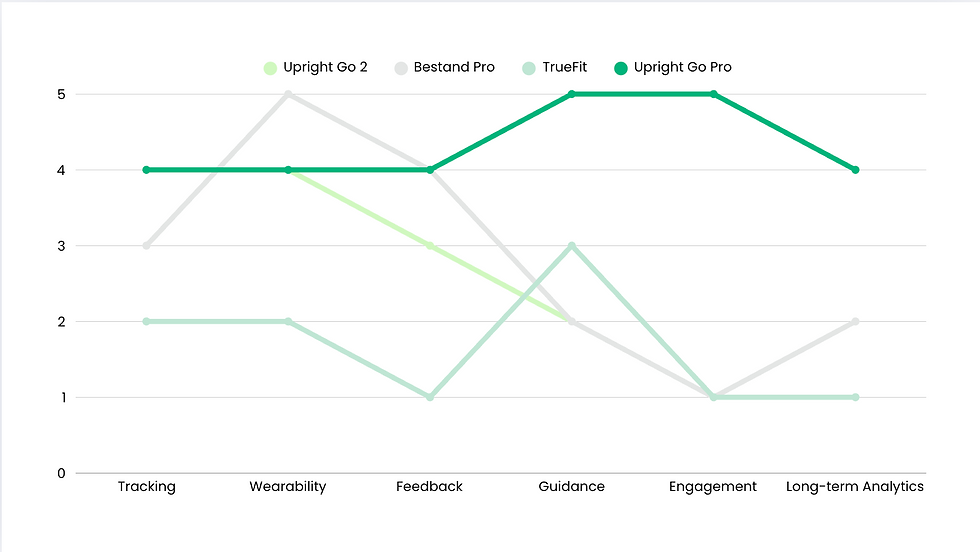
In the sub-$100 market, we aim to enhance guidance, engagement, and feedback delivery to improve user experience and address market gaps.
Stakeholders map
Our primary users are desk workers, who are the focus of this project. They often struggle with poor posture, leading to long-term health issues such as back pain and reduced productivity.
Our goal is to develop a solution that not only supports desk workers directly but also involves key stakeholders (e.g., employers, healthcare providers) to create a sustainable impact.

IDEATION
After two collaborative brainstorming sessions, we generated creative ideas for each of our design goals. We then evaluated and categorized these ideas to ensure they align with user needs and design objectives.

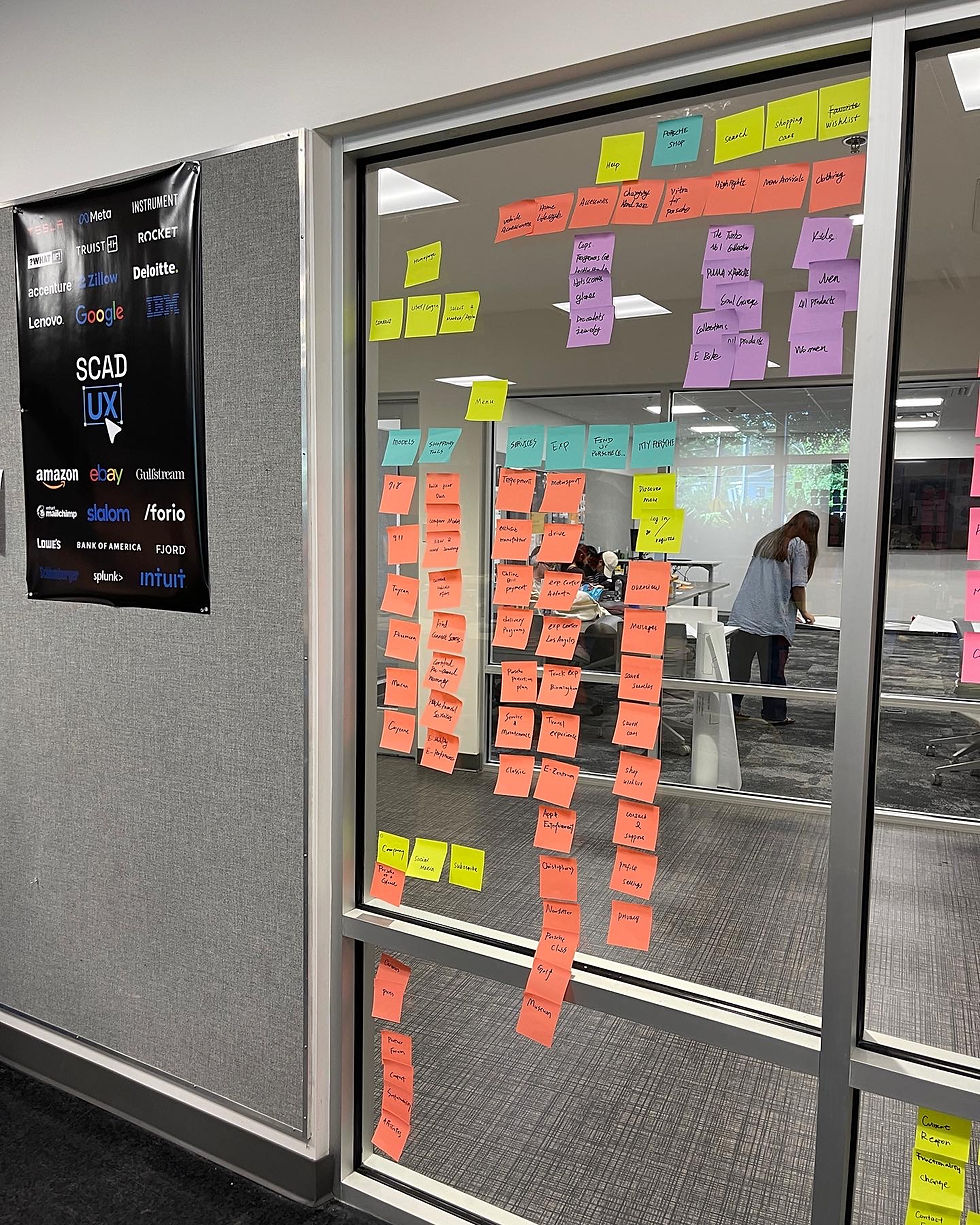
Let’s make these ideas real!
LOW-FI & USER TESTING
We designed two interactive, clickable prototypes for A/B testing and created heat map test links, which we shared with 10 target users. After the test, we conducted interviews and surveys to gather qualitative feedback and analyzed the heat map data to identify areas of confusion, misclicks, and usability issues. These insights helped us refine and improve our design for a better user experience.

-
A/B TESTING
-
HEAT-MAP TESTING
-
INTERVIEW & SURVEY

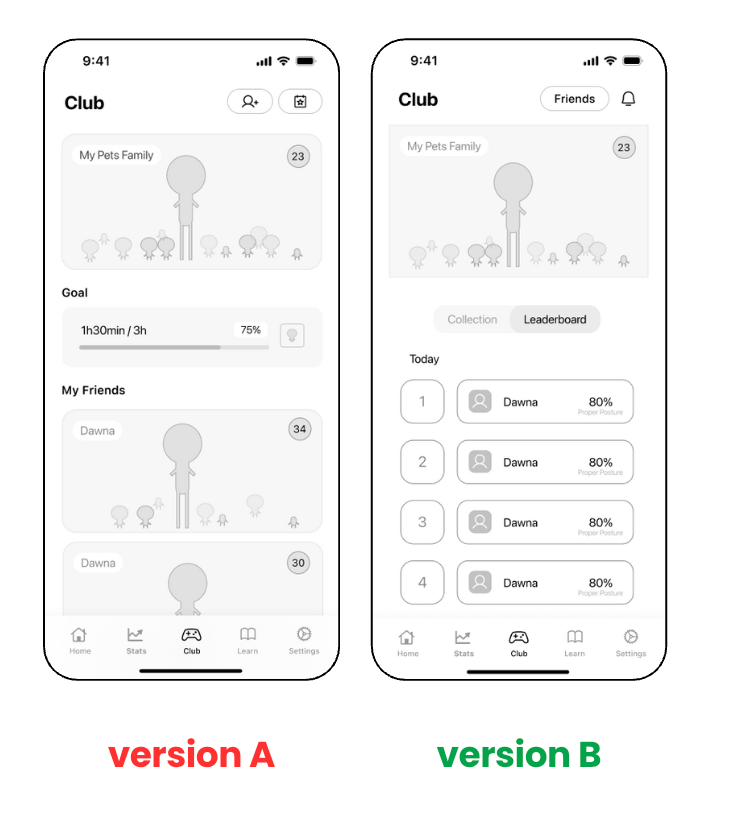


USER QUOTE
“I hope to see my progress on the Static page, with a data table that is clear, easy to read, and easy to understand.”
INSIGHT
Most users indicated that while social features are important, they prefer a layout focused on their own world and virtual pet collection when it comes to “My pets”.
USER QUOTE
The leaderboard with friends makes me really want to beat them, and the competition between friends is a lot of fun.
USER QUOTE
“However, the vibration doesn't really work for me; I need a stronger reminder to be more effective.”
INSIGHT
Users hope this app can be simple and not too complex. They also prefer a clean, aesthetically pleasing interface design.
USER QUOTE
" I love the sense of collecting! The feeling of collecting would motivate me to keep using it."
👀 📱If you're interested, here are the links to the two prototype versions we tested at the time.
🌟
User-Driven Design: Integrating a Desktop Widget for Seamless Reminders
“ I don’t check my phone very often. It would be best to have visual reminders on my computer—that's the approach I like most.”
_
Through observing that multiple users shared similar feedback and suggestions, we made the design decision to create a desktop widget that seamlessly integrates with our product. This widget is tailored to fit users' busy and focused work routines, offering customizable reminder options to enhance their experience.

Visual system
We refined the visual identity of Upright Go Pro using a style tile, which consolidates key brand inspirations, including color palette, typography, and imagery. This serves as a foundation for the UI design process.
Since this project involves a gaming element, I designed various pet character visuals and motion animations.
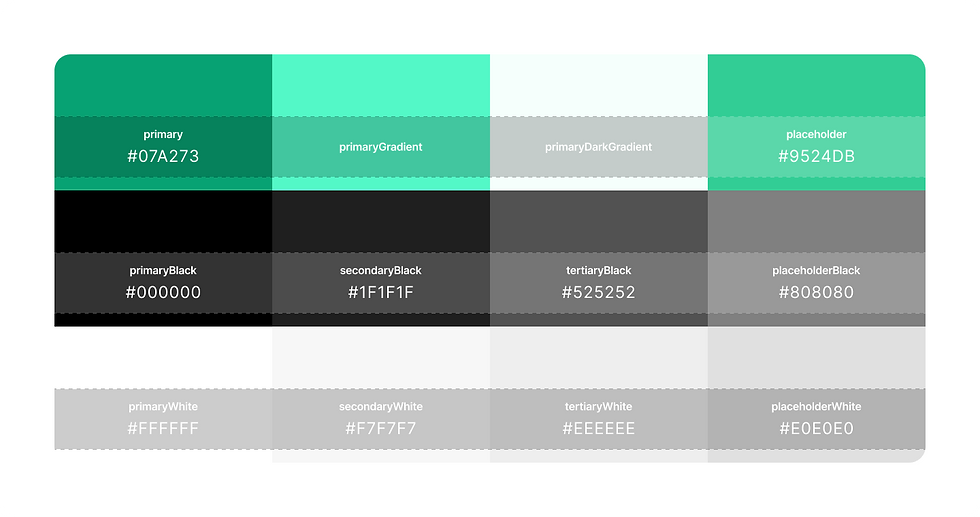
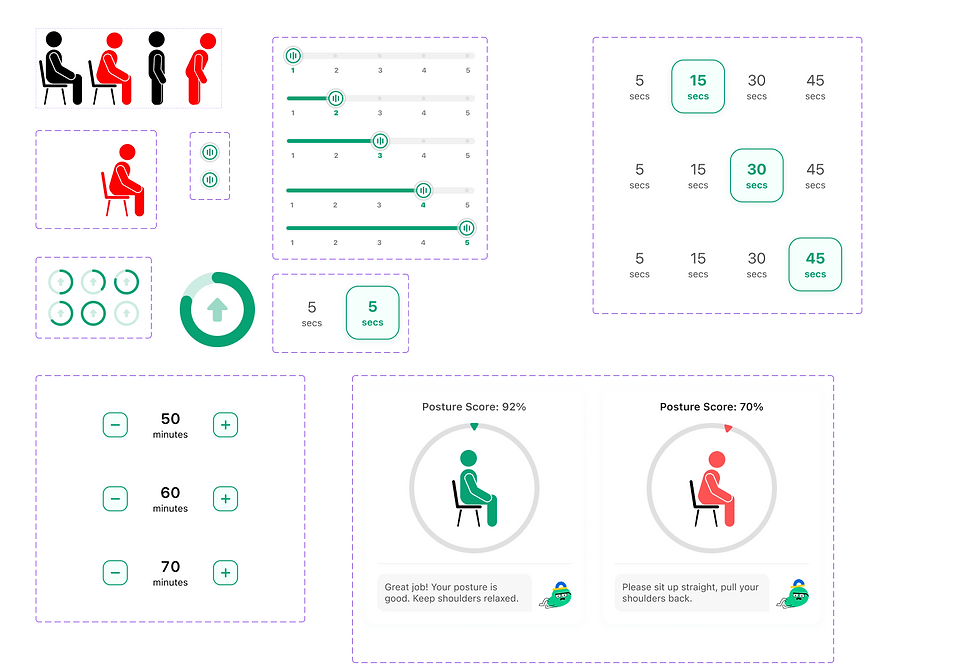

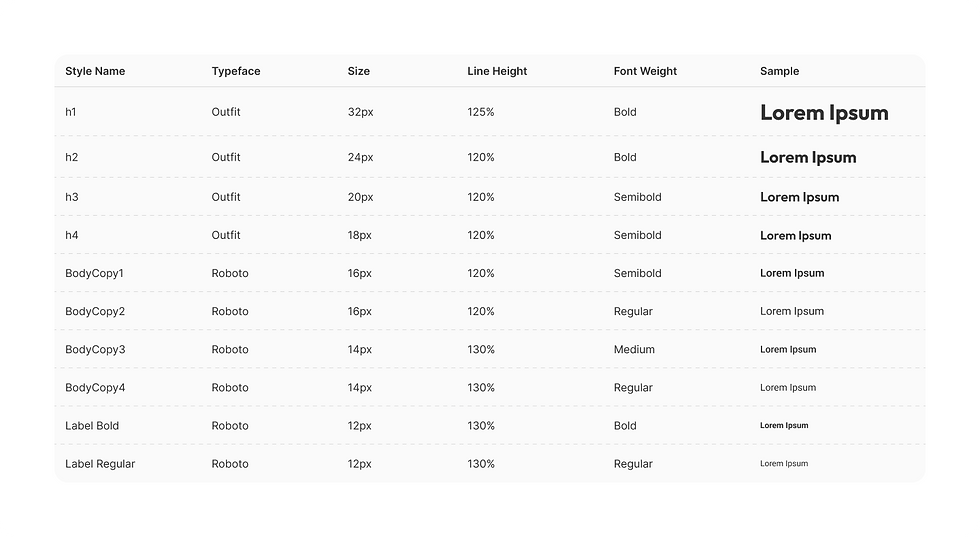



HI-FI
-






💡 MY TAKEAWAYS

Listening to Users
When we couldn’t decide on the best idea, our users had the answer. Their feedback gave us fresh perspectives and helped us see what truly mattered. This allowed us to refine our concepts, ensuring that the final design aligned with actual user needs rather than just our assumptions.
Designing for Real-Life Contexts
Understanding user needs goes beyond just listening to what they say—it’s also about observing how they react and what they need in real-life scenarios. Context matters. By considering the situations in which users interact with a product, we can design solutions that truly fit into their workflow, anticipate their challenges, and support them in meaningful ways.



